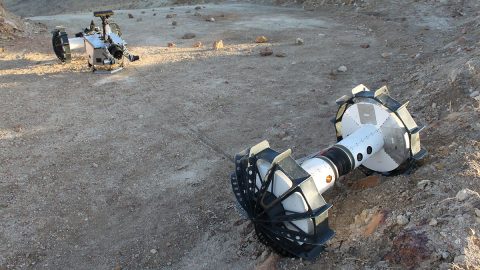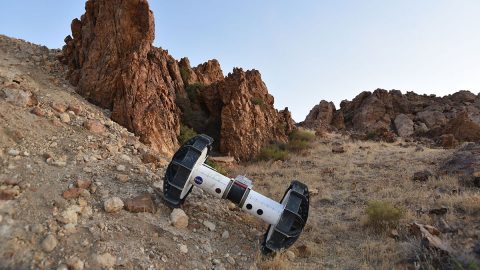 Pasadena, CA – A rover trundles over rocky terrain, its four metal wheels clattering along until they encounter a seemingly insurmountable hazard: a steep slope. Down below is a potential trove of science targets. With a typical rover, the operators would need to find another target, but this is NASA’s DuAxel, a robot built for situations exactly like this.
Pasadena, CA – A rover trundles over rocky terrain, its four metal wheels clattering along until they encounter a seemingly insurmountable hazard: a steep slope. Down below is a potential trove of science targets. With a typical rover, the operators would need to find another target, but this is NASA’s DuAxel, a robot built for situations exactly like this.
The rover is actually made of a pair of two-wheeled rovers, each called Axel. To divide and conquer, the rover stops, lowers its chassis and anchors it to the ground before essentially splitting in two.

With the rear half of DuAxel (short for “dual-Axel”) firmly in place, the forward half undocks and rolls away on a single axle.
All that connects the two halves now is a tether that unspools as the lead axle approaches the hazard and rappels down the slope, using instruments stowed in its wheel hub to study a scientifically attractive location that would normally be out of reach.
This scenario played out last fall during a field test in the Mojave Desert, when a small team of engineers from NASA’s Jet Propulsion Laboratory in Southern California put the modular rover through a series of challenges to test the versatility of its design.
“DuAxel performed extremely well in the field, successfully demonstrating its ability to approach a challenging terrain, anchor, and then undock its tethered Axel rover,” said Issa Nesnas, a robotics technologist at JPL. “Axel then autonomously maneuvered down steep and rocky slopes, deploying its instruments without the necessity of a robotic arm.”

This scenario played out last fall during a field test in the Mojave Desert, when a small team of engineers from NASA’s Jet Propulsion Laboratory in Southern California put the modular rover through a series of challenges to test the versatility of its design.
“DuAxel performed extremely well in the field, successfully demonstrating its ability to approach a challenging terrain, anchor, and then undock its tethered Axel rover,” said Issa Nesnas, a robotics technologist at JPL. “Axel then autonomously maneuvered down steep and rocky slopes, deploying its instruments without the necessity of a robotic arm.”
But the slopes are too steep for a conventional rover – even for Curiosity or the soon-to-land Perseverance rover, both of which are designed to traverse slopes of up to 30 degrees. To explore these features directly would require a different kind of vehicle.
So Nesnas and his team began developing a version of Axel that would be tethered to a lander, using the tether not just to descend a crater side or steep canyon wall, but also to supply power and communicate with the lander.

Its wheels could be equipped with extra-high grousers, or treads, for added traction, while the wheel hubs could house microscopes, drills, sample-collection scoops, and other instrumentation to study the terrain. To turn, the two-wheeled axle would just rotate one of its wheels faster than the other.
Interest in the concept’s flexibility has led to a burgeoning family of two-wheeled designs, including NASA JPL’s A-PUFFER and BRUIE, which extend the possibility of exploration to new destinations and applications, including under water on icy worlds.
Despite the tethered Axel’s versatility, there was a notable limitation when used in conjunction with a stationary lander: The lander would need to be within rappelling distance of the crater side – demanding a degree of landing precision that may not be possible for a planetary mission.
To remove this requirement and boost mobility, the team reverted to the original modular design, adapted it to the new tethered Axel, and named it DuAxel.
“The key advantage of using DuAxel is made clear when you have landing site uncertainty, such as we do on Mars, or you want to move to a new location to rappel and explore with Axel,” said Patrick Mcgarey, a robotic technologist at JPL and DuAxel team member. “It enables untethered driving from the landing site and allows for temporary anchoring to the terrain because it is essentially a transforming robot made for planetary exploration.”
While DuAxel remains a technology demonstration and is waiting to be assigned a destination, its team will continue honing its technology; that way, when the time comes, the robot would be ready to roll where other rovers fear to tread.



